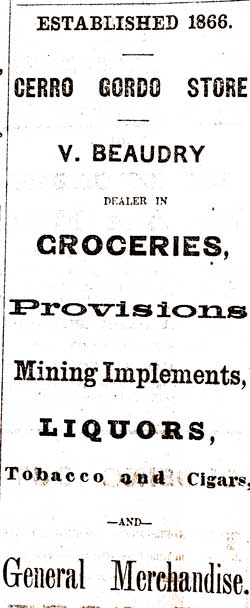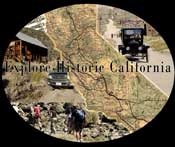Born in Montreal,
Canada, Victor Beaudry followed the 49ers to California for
the gold rush, and wound up in San Francisco with his
brother Prudent. The siblings had a profitable commission
and shipping business until commercial conditions in the
city became unstable. Prudent invested $26,000 of his own
money into a general mercantile. Victor eventually left his
brother with the mercantile, and headed to Central America,
interested in plans for the
|
 |
|
Portrait of Victory Beaudry as he might have during
in his Cerro Gordo days (1866-1876) painted by
Robert C. Likes. |
Nicaragua Canal.
Prudent took over the San Francisco business, eventually
moving to Los Angeles. Prudent’s successes in mercantile and
real estate ventures led him to dabble in politics which in
turn won him position as Mayor of the City of Angeles.
Victor would join him in the real estate and water works in
Los Angeles, but made much of his fortunes in the California
mining industry along the way.
By 1855, placer mining
in the waters of the San Gabriel River caught Victor
Beaudry’s attention. His name was among those listed in
newspaper articles as having helped to form the Santa Anita
Mining Company, with a capital of $50,000. Under his
direction and that of another future mayor of Los Angeles,
Damien Marchessault, hydraulic works were erected for the
mines. A minor gold rush in the San Gabriel Mountains north
of Los Angeles ensued.
Beaudry and Marchessault
also found work to sustain them in down town Los Angeles by
selling block ice to saloon keepers. An ice house was built
in 1859 that enabled the two men to expand their business by
selling door to door throughout the hot summer months.
Beaudry and Marchessault would also have significant impact
on Los Angeles water systems in later years.
The start of the Civil
War in 1861 prompted Victor Beaudry to head east to join the
First Regiment of Infantry, United States regular army. He
fell back on his experience in general mercantile by
providing much needed provisions as a sutler for the
soldiers,. The toll of the war and the hardships he endured
took a toll on Beaudry’s health as the war came to a close.
When fellow officers
moved to Camp Independence in Inyo County, California, they
persuaded him to join them, and open up a store there for
the boys in blue. He also opened the Beaudry Hotel.
Beaudry’s store and hotel both suffered great damages in the
1872 earthquake. The hotel was abandoned after the
earthquake and opened later by a Dr. White as the Inyo
County Hospital.
When Mexican miners
discovered silver on Buena Vista Peak high in the Inyo
Mountains, Beaudry saw opportunities to cash in on mining
once again. Unpaid debts for supplies from his general store
built in 1866 in Cerro Gordo would earn Beaudry rights to
most of the Mexican
 mines.
Within two years he and Mortimer Belshaw shared interests in
the Union Mine. Both men built furnaces to smelt the
precious silver/lead ore which would be shown off in Los
Angeles on it’s way to the port of San Pedro via Remi
Nadeau’s freight wagons and on to San Francisco by
steamships. The output of base bullion produced
approximately 5,000,000 pounds per annum for several years.
mines.
Within two years he and Mortimer Belshaw shared interests in
the Union Mine. Both men built furnaces to smelt the
precious silver/lead ore which would be shown off in Los
Angeles on it’s way to the port of San Pedro via Remi
Nadeau’s freight wagons and on to San Francisco by
steamships. The output of base bullion produced
approximately 5,000,000 pounds per annum for several years.
Water was important for
survival of the mines and the miners in Cerro Gordo which
was situated high and dry on desert mountain top. Victor
Beaudry became known as the “water king” when he ordered
pipe shipped from San Francisco to pipe water from Inyo
Mountain springs to the Cerro Gordo. He would also bring the
precious liquid to the mining town of Darwin from Crystal
and Granite Springs seven and nine miles away.
In 1876, Cerro Gordo’s
mining boom faded, Victor Beaudry found his way back to
Montreal where he married Angelica Le Blanc. They grew to a
family of five children as time went by. From 1881 to 1886,
Victor resided in Los Angeles and partnered with his
brother, Prudent, once again. The Beaudry’s expansion and
land development promotions helped Los Angeles to rise from
pueblo to city with the creation of some of the first
hilltop residential areas with piped water systems,
beautiful landscapes, and cable car transportation to
downtown work areas.
Victor Beaudry died in
1888 in Montreal, but the ghost of Cerro Gordo, and the
thriving metropolis a half a day’s automobile drive away
from it, stand as landmarks to his ventures and visions.
